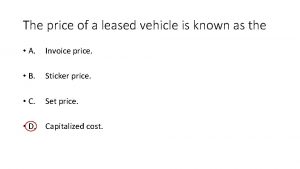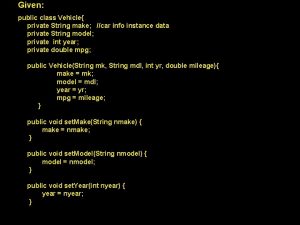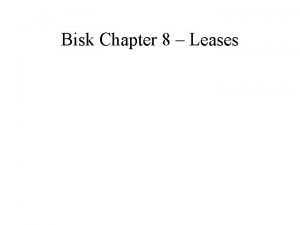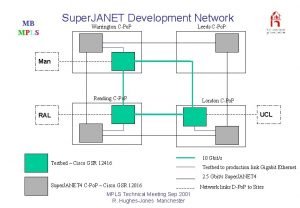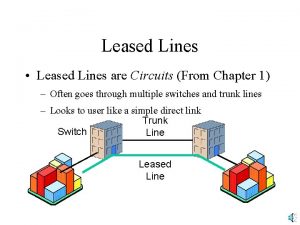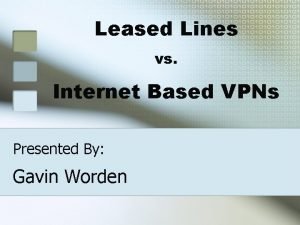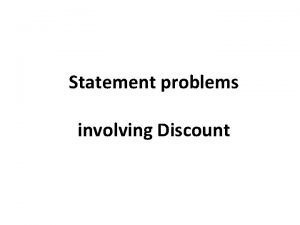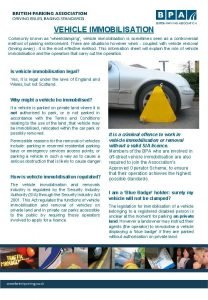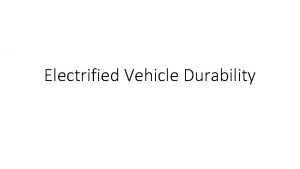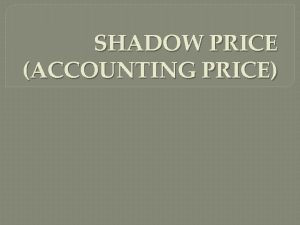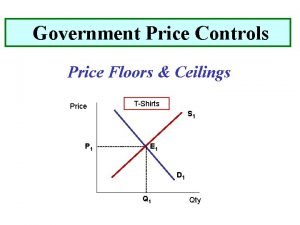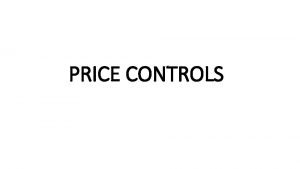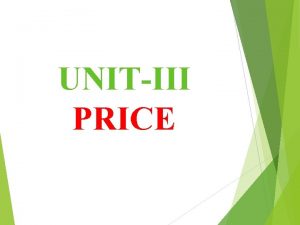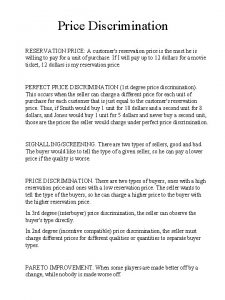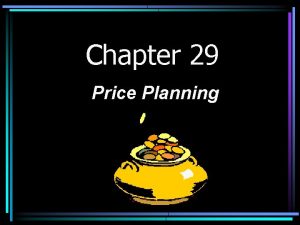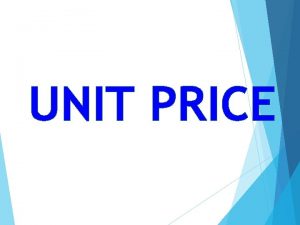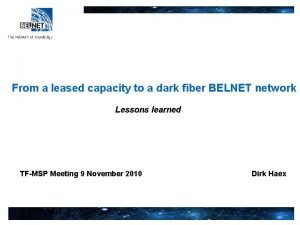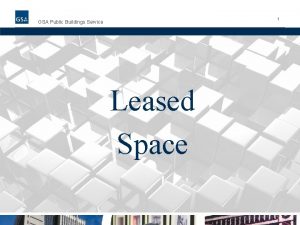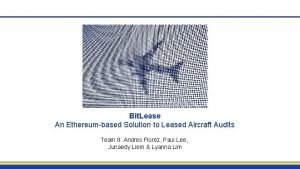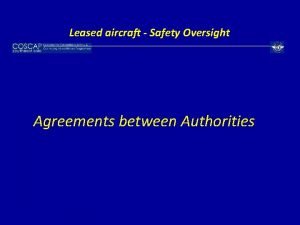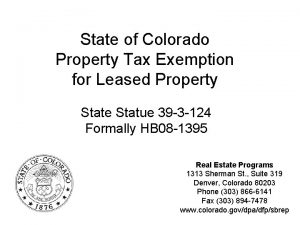The price of a leased vehicle is known


















































- Slides: 50

The price of a leased vehicle is known as the • A. Invoice price. • B. Sticker price. • C. Set price. • D. Capitalized cost.

The expected value of a vehicle at the end of a lease is called the A. B. C. D. Sticker price. Set price. Capitalized cost. Residual value.

The amount printed on a label with the suggested retail price that is posted on a vehicle is called the • A. Invoice price. • B. Sticker price. • C. Set price. • D. Capitalized cost.

When purchasing a used vehicle, it is a good idea to • A. Take out a loan for the entire cost. • B. Accept the dealer at his word about the condition of the vehicle. • C. Have a trained and trusted mechanic of your choice check out the vehicle. • D. All of these are correct.

Which of the following is a disadvantage of a car lease? • A. A large down payment is required. • B. At the end of the lease, you have no ownership interest in the vehicle. • C. The capitalized cost is usually lower than the list price. • D. Monthly lease payments are usually lower than monthly financing payments.

Mike bought a new car. His new car warranty probably included all of the following except • A. Coverage of basic parts against defects. • B. Corrosion warranty. • C. Extended coverage for air conditioning. • D. Power train coverage.

The price of a leased vehicle is known as the • A. Invoice price. • B. Sticker price. • C. Set price. • D. Capitalized cost.

A potential problem with having a long car loan is • A. Low monthly payments. • B. Low-interest loan. • C. Negative equity. • D. Loan preapproval.

All of the following are fixed operating costs for a vehicle except • A. Insurance. • B. Interest on an auto loan. • C. License and registration. • D. Maintenance and repairs.

What is the fee that a policyholder pays when an insurance company agrees to take on the risk? • A. Coverage • B. Deductible • C. Premium • D. Peril

An insurance program • A. Should change along with needs and goals. • B. Should minimize personal property and liability risks. • C. Should be constant through one's life, and should minimize personal property and liability risks. • D. Should minimize personal property and liability risks, and change along with one's needs and goals.

Liability is defined as • A. An insurance program for individuals and households. • B. The legal responsibility for the financial cost of another person's losses or injuries. • C. Negligence. • D. A loss due to physical damage.

Amber had permission from Bradley to borrow his car to run some errands. Unfortunately, while Amber was driving, she looked down to change songs on her phone and sideswiped a car and hit a bicyclist. Based on her experience, which of the following would be true? • A. The insurance company of the owner of the sideswiped car should pay for all damages since the car was illegally parked. • D. Amber's insurance should not cover any damage since she carried liability, collision, and comprehensive coverage. • C. The bicyclist should cover his own medical expenses because he was at fault for riding on the road. • D. Amber's insurance policy should cover any property damage claims since she was driving Bradley's car with his permission.

Medical payments coverage applies to medical expenses of • A. Anyone in your vehicle, including you. • B. Anyone in your vehicle who is injured, except the driver. • C. The driver, but no passengers who are injured. • D. The owner of the vehicle, but not other passengers.

Timothy was driving his friend Nick to football practice. While driving, he was hit by a driver who had coverage of 100/300/50. Tim and Nick each suffered some physical injuries. Based on this information, which of the following is correct? • A. Timothy's injuries would be covered to $100 and property damage would be limited to $300. • B. Individually, Timothy and Nick's injuries would be covered to $300, 000 each. • C. The total coverage for Timothy and Nick would be $100, 000, and the driver who caused the accident would be covered to $50, 000. • D. The policy would provide a maximum of $100, 000 for each of the injured, and no more than $300, 000 for total injuries sustained in the accident.

Sammy was driving on the highway and drove over a piece of metal that was on the highway. The metal punctured her gas tank. This damage would be covered under her • A. Uninsured motorist's protection. • B. Property damage liability policy. • C. Collision policy. • D. Comprehensive physical damage policy.

Madeline had a severe allergy attack and crashed her car into a telephone pole while sneezing. The damage to the telephone pole would be covered under Madeline's • A. Uninsured motorist's protection. • B. Property damage liability policy. • C. Collision policy. • D. Comprehensive physical damage policy.

Henry was driving at dusk and hit a deer running across the road. His damage would be covered under his • A. Uninsured motorist's protection. • B. Property damage liability policy. • C. Collision policy. • D. Comprehensive physical damage policy.

Al left his vehicle parked on the street in the front of his house when he went on vacation. While he was gone, his street flooded and his car was severely damaged. This damage would be covered under his • A. Uninsured motorist's protection. • B. Property damage liability policy. • C. Collision policy. • D. Comprehensive physical damage policy.

Last month some of your friends were injured in an accident. Their total injuries were as follows: Coverage was 100/300/50. What was the total medical coverage in this accident? • B. $85, 000 • C. $125, 000 • D. $225, 000 • E. $250, 000

Which of the following is a disadvantage of renting? • A. Renters have fewer responsibilities than home owners. • B. Tenants cannot take tax deductions for mortgage interest and property taxes. • C. Renters usually do not have to be concerned with maintenance and repairs. • D. Taking possession of a rental unit is less expensive than buying a home.

A legal document that includes information about the due date of monthly rent is called a • A. Lease. • B. Lessee. • C. Lessor. • D. Rental statement.

Which of the following is NOT a benefit of home ownership? • A. Personalized living location • B. Deductibility of mortgage interest • C. Deductibility of real estate taxes • D. Maintenance and costs of repairs and home improvements

Which of the following is a legal form of ownership in which the owners pay a monthly fee for maintenance of the common areas? • A. Condominium • B. Cooperative housing • C. Manufactured home • D. Single-family dwelling

What should a home buyer consider when evaluating a house? • A. Zoning laws. • C. School system. • D. Property values of the community. • D. All of the above

When Ingrid was selling her house, she contacted Gabe, her real estate agent, to help her with the sale. Gabe's services included all of the following except • A. Negotiating a settlement price. • B. Receiving an offer from a buyer. • C. Representing Ingrid at the closing. • D. Home appraisal.

Madeline wants to purchase a larger house. However, she has not yet sold her current home. She may want to include a(n) ____ in her offer. • A. appraisal • B. contingency clause • C. dual agent • D. earnest money

Opal is a real estate agent who represents the buyer as well as the seller. In some states, the buyers are required to sign a disclosure acknowledging that they are aware that Opal is working as a(n) • A. Appraisal. • B. Contingency clause. • C. Dual agent. • D. Earnest money.

Private mortgage insurance • A. Cannot be avoided. • B. Is part of all mortgages. • C. Is usually required if the down payment is less than 25%. • D. Must be terminated automatically when the home owner's equity reaches 22% of the property value at the time the loan was initiated.

Rebecca paid extra money to reduce her mortgage interest rate. That extra money is called • A. Escrow. • B. Lock. • C. PMI. • D. Points.

When Smee applied for a loan, he was assured that his rate would not change if he closed within a specific time period. Smee had a(n) ______ on the interest rate. • A. amortization • B. escrow • C. lock • D. PMI

Because Dan served in the army, he should be eligible for a(n) • A. FHA loan. • B. Negative amortization. • C. Conventional loan • D. VA loan.

Ursula wants plans on living at her future house for less then 5 years. Currently, she is shopping around for rates. What type of loan do you recommend for her? • A. ARM. • B. Fixed • C. Negative amortization. • D. Payment cap.

Which of the following is the document that transfers ownership of property from one party to another? • A. Deed • B. Escrow • C. Mortgage • D. PMI

Which of the following is an account used to pay property taxes and home insurance? • A. Deed • B. Escrow • C. Mortgage • D. PMI

Given the information here, what is the total cost of renting per year? • A. $14, 400 • B. $14, 700 • C. $14, 710 • D. $164, 400

Homeowner's insurance covers all of the following except • A. A detached garage. • B. A tool shed. • C. Personal property. • D. All of these are covered.

Which of the following is NOT correct about renter's insurance? • A. The broad form covers personal property against perils specified in the policy. • B. Renter's insurance covers the building and other structures on the site. • C. The comprehensive form protects personal property against perils not specifically excluded in the policy. • E. Renter's insurance includes personal property protection, additional living expenses, and personal liability.

Vincent is applying for insurance for his new home. Which of the following is correct? • A. He should base the amount of insurance on the price he paid for it. • B. He should insure the building for 75% of its replacement cost. • C. He should use the actual cash value method for settling claims to receive the full cost of repairing or replacing his personal belongings. • D. His personal belongings should automatically be covered with his home at 55 -75% of his home's insured amount.

Sandra is contacting several insurance companies to compare coverage for her home. Which of the following should NOT affect her premium? • A. Alarm system • C. Type of structure • D. Deductible • E. Proximity to a school

Tom wanted to receive as many discounts on his home insurance as possible. Which of the following would NOT provide a discount? • A. Fire extinguisher. • B. Deadbolt locks. • C. Alarm systems. • D. All of these should provide a discount for Tom.

An insurance company will • A. Insure speculative and pure risks. • B. Insure pure risk, but not speculative risk. • C. Insure neither pure risk nor speculative risk. • D. Insure speculative risk, but not pure risk.

The two basic types of risk that people face regarding their personal property are • A. Basic and criminal. • B. Physical damage and destruction. • C. Destruction and basic. • D. Physical damage and damage caused by criminal behavior.

Homeowner's insurance covers all of the following except • A. Personal property. • B. Personal liability. • C. Additional living expenses. • D. Automobiles.

All of the following are acceptable types of documentation for a household inventory except • A. Photographs with dates purchased and values of objects listed on the backs. • B. Video recordings of assets. • C. Computerized spreadsheets with details about the items and their ages and costs. • D. A listing of items and their details in your memory.

Personal property insurance covers • A. Furniture and appliances, but not clothing or some electronics. • B. Clothing and some electronics, but not furniture and appliances. • C. All items up to 200% of the insured value of the home. • D. Personal property items up to 55 -75% of the insured value of the home.

A policy that supplements your basic personal liability coverage is called a(n) • A. Homeowner's insurance. • B. Medical payments coverage. • C. Supplementary policy. • D. Umbrella policy.

When Stanley was visiting Elaine, he tripped on her front porch step and sprained his ankle. His injuries were covered by • A. Elaine's medical payments coverage. • B. Stanley homeowner's policy. • C. Elaine's health insurance coverage. • D. Elaine's life insurance policy.

What type of insurance when paired with your homeowners, lowers your homeowners premium? • A. Life Insurance • B. Automobile Insurance • C. Health Insurance • D. Renters Insurance

If you have a loss due to a flood • A. Your homeowner's insurance should normally cover the loss. • B. You need to have purchased special coverage if you live in an area that has frequent floods in order to be covered. • C. FEMA (Federal Emergency Management Agency) will automatically provide coverage if this is your second flood loss. • D. You need an umbrella policy for coverage.
 The price of a leased vehicle is known as the
The price of a leased vehicle is known as the Ano ang ibang katawagan ng price ceiling
Ano ang ibang katawagan ng price ceiling Cosmic superclass in java
Cosmic superclass in java Oak co leased equipment
Oak co leased equipment Retail institution by ownership
Retail institution by ownership Wan technologie
Wan technologie Tot leased line internet
Tot leased line internet Skema hubungan leased line
Skema hubungan leased line Mpls leased line warrington
Mpls leased line warrington Leased circuit
Leased circuit Leased line vpn
Leased line vpn Hire purchase system and installment system
Hire purchase system and installment system Reactive purchasing
Reactive purchasing Price discovery and price determination
Price discovery and price determination Marked price-selling price=
Marked price-selling price= Tư thế ngồi viết
Tư thế ngồi viết Thế nào là mạng điện lắp đặt kiểu nổi
Thế nào là mạng điện lắp đặt kiểu nổi đặc điểm cơ thể của người tối cổ
đặc điểm cơ thể của người tối cổ Lời thề hippocrates
Lời thề hippocrates Các châu lục và đại dương trên thế giới
Các châu lục và đại dương trên thế giới Cách giải mật thư tọa độ
Cách giải mật thư tọa độ Tư thế worm breton là gì
Tư thế worm breton là gì Thẻ vin
Thẻ vin Khi nào hổ mẹ dạy hổ con săn mồi
Khi nào hổ mẹ dạy hổ con săn mồi Cái miệng xinh xinh thế chỉ nói điều hay thôi
Cái miệng xinh xinh thế chỉ nói điều hay thôi Các châu lục và đại dương trên thế giới
Các châu lục và đại dương trên thế giới Dot
Dot Bổ thể
Bổ thể Thế nào là giọng cùng tên?
Thế nào là giọng cùng tên? 101012 bằng
101012 bằng Thiếu nhi thế giới liên hoan
Thiếu nhi thế giới liên hoan Thể thơ truyền thống
Thể thơ truyền thống Hát lên người ơi alleluia
Hát lên người ơi alleluia đại từ thay thế
đại từ thay thế Vẽ hình chiếu vuông góc của vật thể sau
Vẽ hình chiếu vuông góc của vật thể sau Hệ hô hấp
Hệ hô hấp Số.nguyên tố
Số.nguyên tố Công của trọng lực
Công của trọng lực Tỉ lệ cơ thể trẻ em
Tỉ lệ cơ thể trẻ em Vẽ hình chiếu đứng bằng cạnh của vật thể
Vẽ hình chiếu đứng bằng cạnh của vật thể Phản ứng thế ankan
Phản ứng thế ankan ưu thế lai là gì
ưu thế lai là gì Quá trình desamine hóa có thể tạo ra
Quá trình desamine hóa có thể tạo ra Các môn thể thao bắt đầu bằng từ đua
Các môn thể thao bắt đầu bằng từ đua Hình ảnh bộ gõ cơ thể búng tay
Hình ảnh bộ gõ cơ thể búng tay điện thế nghỉ
điện thế nghỉ Từ ngữ thể hiện lòng nhân hậu
Từ ngữ thể hiện lòng nhân hậu Nguyên nhân của sự mỏi cơ sinh 8
Nguyên nhân của sự mỏi cơ sinh 8 Tư thế ngồi viết
Tư thế ngồi viết Trời xanh đây là của chúng ta thể thơ
Trời xanh đây là của chúng ta thể thơ Chó sói
Chó sói
